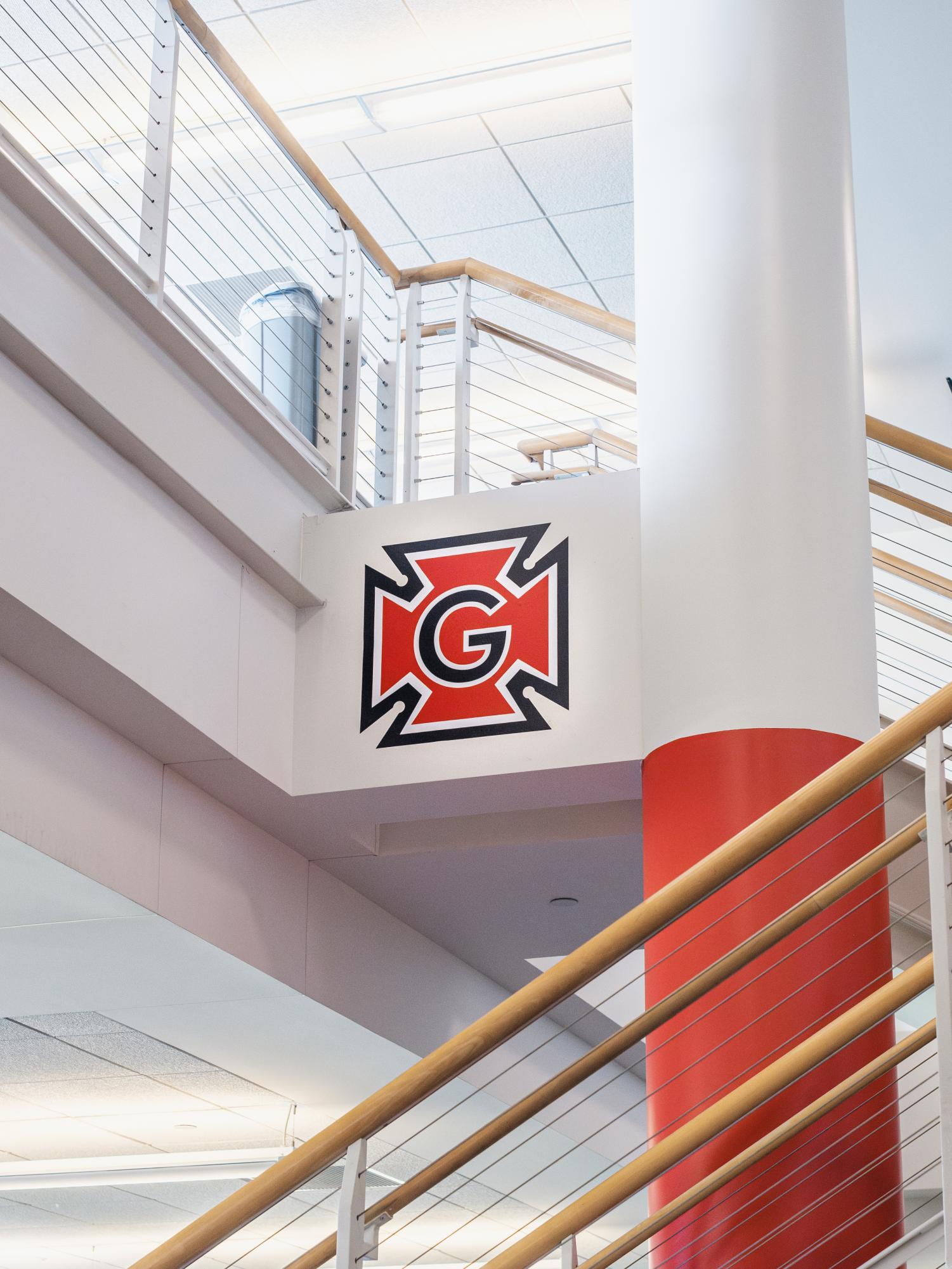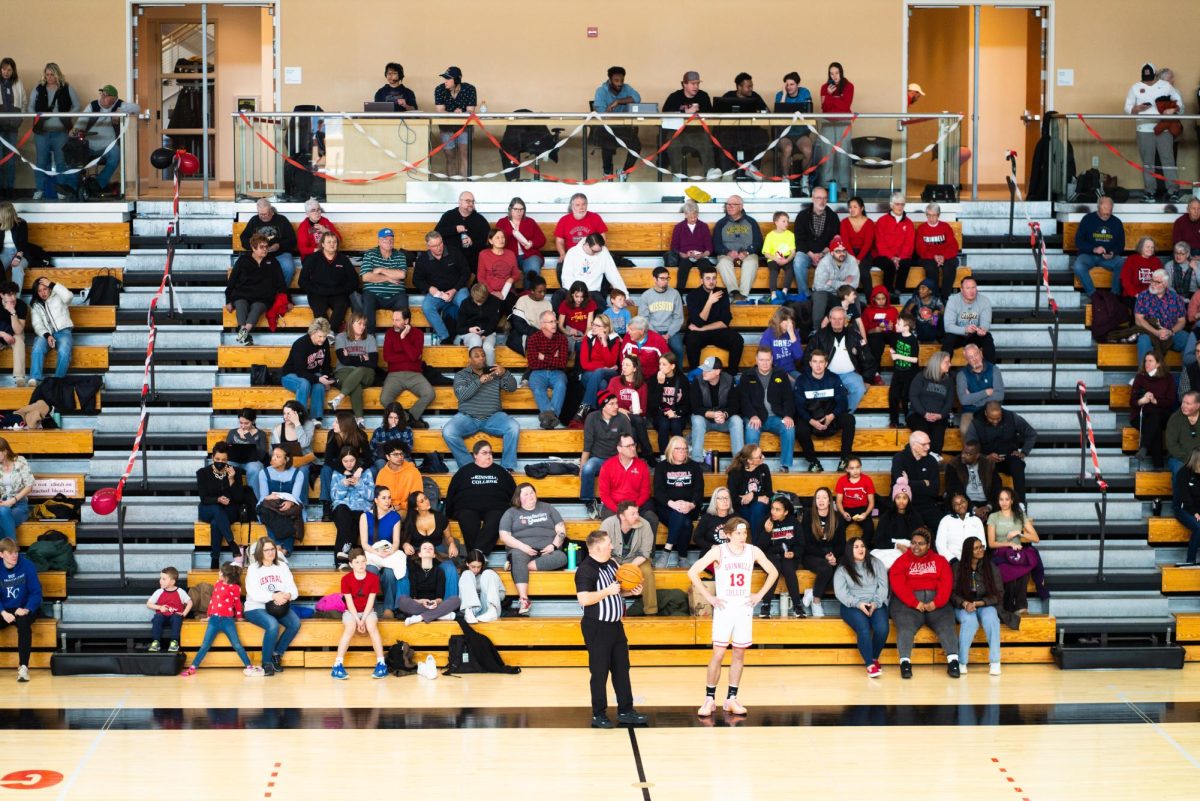Grinnell coaches say they’ve been asked to refrain from printing Grinnell College’s “Honor G” logo on any new gear until further notice, according to head men’s soccer coach Brian Jaworski and head women’s soccer coach Kirsten Koester. The logo has drawn comparisons to the German Iron Cross, a symbol used by Nazi Germany and, more recently, white nationalists.
Director of Recreation and Athletics Holly Roepke said she had no knowledge of any confirmed changes to or removal of the logo. “We are currently in a review process to use an outside firm to help us with all marketing, and [the Honor G] would be part of our review,” Roepke said.
“We [The College] will be evaluating the mascot, the Honor G, the use of nicknames, how the laurel leaf logos are used, and other parts of our marketing communications program as part of a holistic effort to review all aspects of Grinnell’s brand,” said Ellen de Graffenreid, Vice President of Communications and Marketing.
The Honor G was created in 1892, when it bore the letters I and C, due to Grinnell College being known as Iowa College at the time. Other than replacing the I and C with a G in 1894 and an unpopular change of font in the 1930s that was later reversed, the logo has not changed since.
“All athletic teams were told that they could not print the Honor G on any athletic gear by athletic administration until further notice,” Jaworski said.

“I think it’s complicated. I would say I’m supportive [of] what’s best for the institution,” said Roepke. “And so I think that there’s a lot of work involved. I don’t want to diminish the harm that this imagery causes, but it’s complicated.” Roepke, who is in the first year of her role, said that there was already a conversation about changing the logo when she joined.
She added that complications with removing the logo stem from balancing its potential harm with “the foundation of all of those who have felt some sort of identity with this [Honor G] emblem.” Roepke acknowledged that while the logo originally had no association with Nazism, its meaning has changed over time.
Katya Gibel Mevorach, professor of anthropology, said that the Honor G greatly resembles the Iron Cross, especially due to the similarities between Grinnell’s colors and those of Nazi Germany. Katya, as she prefers to be referred to, said she identifies as Black and Jewish.
She said she first brought up the issue of similarities between the Honor G and the Iron Cross in 2014 and again in 2021. She said that she has received “typical administrative answer” in 2021, adding that she was told many times in the last decade that the College is “looking into it.”
“My objection to the ‘Honor G’ is anchored here: it is an icon whose ‘honor’ was invalidated once adopted by the Nazis and it is time to confront and unpack this inconvenient truth rather than hide behind the mantle of a ‘tradition’ that neither Jews nor Blacks shared in making,” Katya wrote in a 2014 document detailing issues with the logo.
Katya acknowledged the aspect of tradition, but said she did not see it as justification. “It used to be a tradition to not use pronouns. We use pronouns now. It used to be a tradition to not allow women to vote. It was a tradition not to go to not to let American Black kids go to schools in the South that were white or that were private,” Katya said.
Katya said that since she first brought the issue up in 2014, there has been no progress in its removal. In 2021, Katya said she pushed for change again but said she received only vague responses and no action was taken.
“There’s nothing, there’s absolute silence,” Katya said, referring to the response from the College in the last 10 years. “It’s as if nobody ever talks about it. When I brought it up, the response [was] ‘we’re looking into it.’ Well, it’s a decade of looking into something.”
Editor’s Note: The headline and lede of this story have been changed for clarity. A statement from de Graffenreid was added for further context and accuracy.




















Robert Krause • May 5, 2024 at 9:49 pm
My freshman year (1980) in my inaugural tournament on the Grinnell golf team, I used an Honor G ball to make a hole-in-one. Coach Bowers had that traditional logo printed on the balls because he felt that Nazi hijacking of the Maltese Cross was far transcended by its ancient honor as a Christian symbol. He considered the Honor G an important symbol of the student-athlete tradition at Grinnell . That ball still sits on my desk. So yes, the honor G and my athletic experience at Grinnell mean a lot to me. A simple Google search of the Maltese, eight-pointed cross shows an incredible number of uses across the centuries—most which involve service and honor. I urge the college to understand this subtlety—and Grinnell’s laudable use of this symbol—as it looks at the Honor G.
Matt Golden • May 4, 2024 at 5:32 pm
I want to point out that many Jewish and Black athletes participated in creating and sustaining the honor G tradition. My dad, a Jewish athlete at Grinnell in the late 1940s and early 1950s, lettered in several sports. I don’t have an opinion about keeping or changing the symbol, but I don’t think it’s accurate to say Jewish and Black students haven’t played an important part in Honor G tradition.
Katherine Babb • May 3, 2024 at 5:40 pm
So thoughtful and well researched!
P ‘07, P ‘11 • May 2, 2024 at 11:41 am
Regarding the Iron Cross, I look to the Anti-Defamation League and their advice about the symbol: “… the use of the Iron Cross in a non-racist context has greatly proliferated in the United States, to the point that an Iron Cross in isolation (i.e., without a superimposed swastika or without other accompanying hate symbols) cannot be determined to be a hate symbol. Care must therefore be used to correctly interpret this symbol in whatever context in which it may be found.”
Alumnb • May 1, 2024 at 3:49 pm
What an absolute JOKE. I am happy that the S&B included where this all stemmed from. The College should continue their silence towards the singular individual pushing this as this issue deserves absolutely zero attention.
Matt • Apr 30, 2024 at 6:41 pm
Thanks for the well done article. This topic does not deserve any intellectual energy from any administrator. It’s not a nazi symbol. No one in their right mind would confuse Grinnell for subtly supporting nazis with a logo. No one needs this exercise except perhaps the egotistical minds of the ones complaining. Done.
Alumna • Apr 30, 2024 at 6:14 pm
This is some bullshit!
Alumna • Apr 30, 2024 at 10:43 am
It did always look like an Iron Cross to me. That comparison seems very apparent, and it was a morbid inside joke between me and my friends (at some point there was a large handmade[?] Honor G at or within proximity of German House).
Jonathan Breitzer • Apr 30, 2024 at 12:13 am
It never occurred to me that it would resemble an Iron Cross. The Iron Cross is curved radially; this one is straight. If anything, it resembles more the Maltese cross that’s common for firefighters. On the other hand, if it has suggested the Iron Cross for others, maybe that’s reason to retire it.
Alumna • Apr 29, 2024 at 6:19 pm
It’s also the exact same shape as the Victoria Cross, for what it’s worth.
Norm Dahm • Apr 29, 2024 at 3:40 pm
Interesting article. Perhaps someone should research the intent of the Honor G Cross. How did it make it past WW1 and WW2? Why now?
P '07, P '11 • May 2, 2024 at 12:51 pm
Norm: in the late 1930s when plans for the original Darby Gym on 8th Ave were drawn, there was a huge Honor G at the top of the building. When the gym was actually built in the early 1940s, the Honor G was replaced by a giant torch (which reminded many of a spectacular ice cream cone). Why the replacement? I couldn’t find any records which addressed the reason. Yet, it is logical to assume that at the height of WWII, the Honor G was temporarily demoted from prominent displays.
Stephanie Cohen • Apr 29, 2024 at 3:38 pm
I’ll admit that it always looked very much like an Iron Cross to me, and even as an athlete and recipient of an award blanket it has made me twitchy about displaying it. Class of ’82
Andy Laing • Apr 29, 2024 at 12:42 pm
It’s always reminded me of a German iron cross. It’s time to replace it. I’m class of 1990.
Eric S. • Apr 28, 2024 at 10:32 pm
Meanwhile every fire department across the globe uses the same red cross on it.
Rick Stuck • Apr 28, 2024 at 7:57 pm
That is a bunch of bullshit. It is a great logo.
Milton Walser • Apr 28, 2024 at 7:04 pm
Travesty
Foolishness
Nonsense
Concerned Local Alum • Apr 28, 2024 at 6:04 pm
Wondering whether any of the hundreds of current student-athletes, or thousands of alumni athletes, will be (were?) consulted regarding this change? Or are we looking at another instance where a few people, who have no understanding of, nor appreciation for, the school’s history, will make a decision that lacks transparency and disregards Grinnell’s pioneering approach to academics and athletics?
Proud Alum • Apr 29, 2024 at 4:14 pm
This is really disappointing. The Honor G represents not only pride but a symbol of the Grinnell community, including for student-athletes who contribute to both academics and athletics for the school and community. As an alum with a Jewish family background, I wore the Honor G with pride. I still wear my Grinnell College gear to date. It is disheartening that a non-Grinnell alum from the prestigious Duke University wants to impose her beliefs on everyone else.
Does the S&B know if any issues have ever been raised about the Washington & Lee University school logo?
The Honor G does not symbolize antisemitism. We should be proud as Grinnellians.